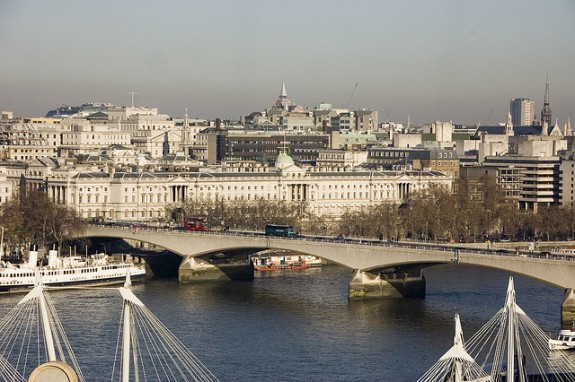This Bridge Is Nicknamed the ‘Ladies Bridge’ Because It Was Built Largely by Women
Women built the Waterloo Bridge, but their contributions were largely lost to history

The Waterloo Bridge in London is nicknamed “The Ladies Bridge” for the women who built it. Photo: Chris March
As World War II overtook Europe and men went off to battle, the women of England, much as in America, entered—or were conscripted into–the wartime workforce. “Before long,” says the BBC, “women made up one third of the total workforce in the metal and chemical industries, as well as in ship-building and vehicle manufacture.” They also worked on English infrastructure: “They worked on the railways, canals and on buses. Women built Waterloo Bridge in London.”
But where Rosie the Riveter became an icon of women’s invaluable role in America’s efforts during World War II, the women who built the Waterloo Bridge were largely forgotten. “Today the riverboat pilots on the Thames tell the story of Waterloo Bridge being built by women in World War 2,” says the description to The Ladies Bridge, a documentary by filmmaker Karen Livesey. “Official history has written this story out as historian Dr Chris Wall discovered after years of trawling through archives.”
‘The Ladies Bridge‘ by Karen Livesey. The transcript of the full documentary can be found online.
Though a crew of largely women workers built the current Waterloo Bridge in the early 1940s, at the official opening of the bridge in 1945, says the documentary, Herbert Morrison, an English politician, thanked all the men who worked on the project:
The men who built Waterloo Bridge are fortunate men. They know that, although their names may be forgotten, their work will be a pride and use to London for many generations to come. To the hundreds of workers in stone, in steel, in timber, in concrete the new bridge is a monument to their skill and craftsmanship.
The displacement of women’s role in the history of the Waterloo Bridge, says a 2006 article in Concrete Construction, wasn’t out of malice, or discrimination. Peter Mandell, the head of Peter Lind and Company, the contractor that oversaw the building of the bridge in 1940s, said “there’s no hidden agenda behind their unacknowledged achievements—the archive was simply lost when Lind temporarily suspended trading in the 1970s. “We’re very proud of our female workforce,” he says. “We’re rebuilding this archive and want to honor them with a plaque on the bridge.”
H/t Alice Bell
More from Smithsonian.com:
/https://tf-cmsv2-smithsonianmag-media.s3.amazonaws.com/accounts/headshot/smartnews-colin-schultz-240.jpg)
/https://tf-cmsv2-smithsonianmag-media.s3.amazonaws.com/accounts/headshot/smartnews-colin-schultz-240.jpg)